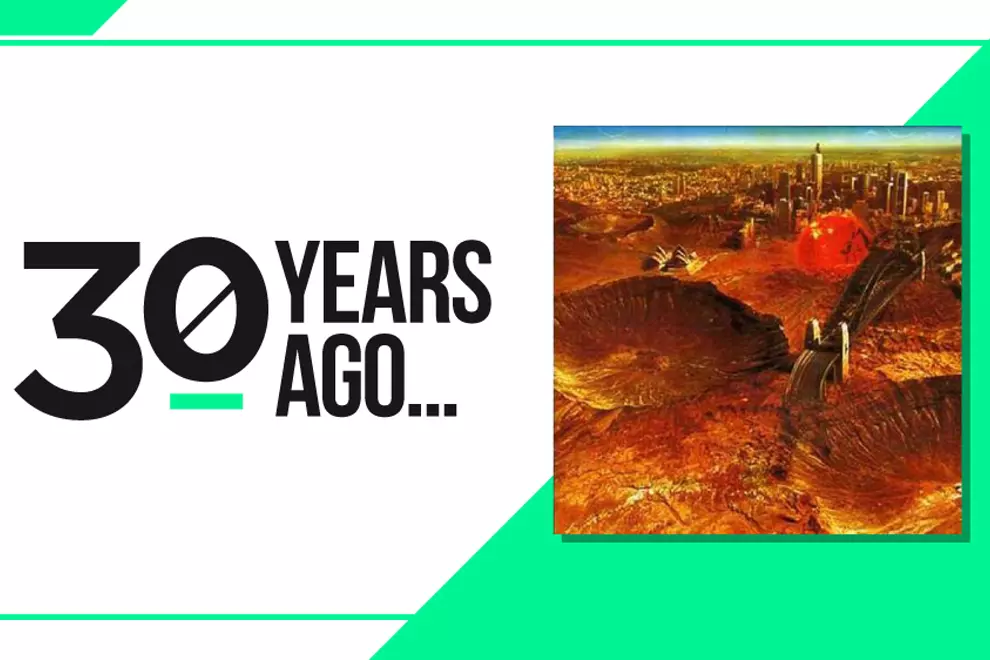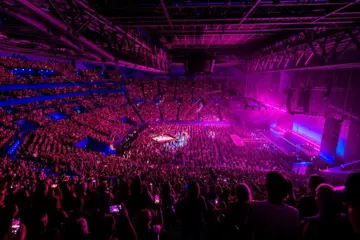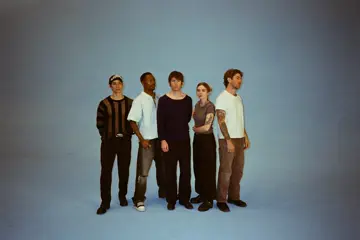Band: Midnight Oil
Album: Red Sails In The Sunset
Label: CBS/Sony
Release Date: 1 October 1984

For years and years as a teen (and probably beyond) I had a poster of the cover of Midnight Oil’s fifth album Red Sails In The Sunset bluetacked to the back of my bedroom door. It’s a depiction of post-apocalyptic Sydney Harbour (by Japanese artist Tsunehisa Kimura) – a manifestation of the era’s collective fears, the Cold War having lingered for decades and peace seeming to teeter on a knife edge – but all of that mattered nought to me as a youngster. Whilst I fully comprehended the political connotations of the Oils’ music (and their various stances) – full appreciation of which would (thankfully) occur much later – the poster to me at the time simply denoted a rad album cover by a kickass rock band, which in a way encapsulates the duality of this amazing outfit. The marriage of music and politics has rarely sat so comfortably and been so widely appreciated as it did with the pioneering Sydney outfit, and one of the major examples of this union is without doubt Red Sails….
Midnight Oil were always a band with a social and political edge to their music – even as early as 1978 (the band started formally in 1976) they’d played an anti-uranium mining concert at Sydney Town Hall – and this collective conscience seemed to grow with their rapidly-expanding profile and popularity. Yet while the preceding album 10,9,8,7,6,5,4,3,2,1 (1982) explored political and societal issues relentlessly, it was nowhere near as overt nor focussed as Red Sails… was in regards its anti-nuclear message. At the time the arms race between the USA and Soviet Union seemed to be scarily escalating, the Bob Hawke-led Labor government of the day was perceived to be changing their stance on uranium mining (allowing Roxby Downs in SA to be mined for the first time) and the US presence in Pine Gap was still shrouded in mystery – accordingly Midnight Oil frontman Peter Garrett had spent much of 1984 involved in the nascent Nuclear Disarmament Party (NDP) to the point that if a federal election was called (which Hawke eventually did on 1 December) he was likely to be called on by the NDP to run for Senate (he eventually received 9.6% of the vote in NSW but missed out due to adverse distribution of preferences). While the Oils were already a massive proposition in Australia, Garrett’s public profile had escalated to the point that he was now more public figure than rock star (if he’d ever been such a thing). None of which was a surprise – in 1983 they’d organised the ‘Stop The Drop’ Nuclear Disarmament concert (which scored a UN Media Peace Prize), and they’d performed Short Memory in its entirety for the local anti-nuke motion picture One Night Stand which came out in May, 1984 (strangely the film was largely set in Sydney Opera House during the onset of nuclear war in Europe amidst fears Sydney could be the next target – you have to wonder if Red Sails…’ cover is related to this premise) – yet it all seemed to manifest on the band’s new album.

Apart from the cover art and the album title (an old Bing Crosby song, sometimes covered by The Beatles in their Hamburg years, which was seemingly pilfered to mirror the cover’s imagery of Sydney Opera House reflecting nuclear devastation) the album is rife with anti-nuke sentiments (continuing the theme of tracks such as Maralinga and Read About It from 10,9,8…). The most obvious example is Minutes To Midnight (“I look at the clock on the wall/It says three minutes to midnight”) which was about the Doomsday Clock, which had just been moved by the Bulletin Of The Atomic Scientists to three minutes to midnight (the point of nuclear holocaust), still the closest to midnight it’s been to this day since the advent of hydrogen bombs in the ‘50s. Elsewhere Shipyards Of New Zealand is aimed at the US use of Kiwi shipyards as missile bases, the grim Harrisburg releates to the Three Mile Island nuclear accident of 1979 and the final imagery of Who Can Stand In The Way pictures a desolate and abandoned inner-Sydney, while tracks like When The Generals Talk and Helps Me Helps You aim to foster distrust in mainstream politics (you’d assume to help fuel the NDP’s outsider objectives). Of course it’s (thankfully) not all anti-nuclear ranting, they cover other ground equally as well – the plight of Indiginous Australians is emphatically touched upon (Kosciusko, Jimmy Sharman’s Boxers and, some posit, Sleep), so too rampant consumerism and corporate greed (Who Can Stand In The Way). And it wasn’t all doom and gloom, the Oils were good at putting a positive spin on scenarios in an aim to galvanise action rather than despair, hence we get the uplifting and cautiously optimistic Best Of Both Worlds, and even the over-arching sentiment of hyper-critical tracks like Minutes To Midnight hint at the possibilty of change (“hope is what you say and do”).

Don't miss a beat with our FREE daily newsletter
Naturally all of this political ranting needs to be taken in the context of the time. Australia in the mid-‘80s was a largely ambivalent place, far-flung and remote enough to be nonchalant, and Midnight Oil were one of the first public entities to really shine a light on not only the bad things happening in our backyard and the potential threats to our becoming the nation that we had (have) the potential to be, but also the general apathy of the general populace in regards recognising (let alone addressing) these concerns. In the pre-internet age when the dissemination of information was more of a challenge – especially that potentially deemed counter to public harmony – music had more potential to act as a platform or medium to get a message across (espeically compared to today with the advent of social media and other information-related technologies). So, importantly, Midnight Oil sought to couch their counsel in brilliant rock’n’roll. They put on incendiary live shows – anyone who saw the Oils in their prime will no doubt recall the spectre of the huge, bald Garrett spasming around the stage like he was being electrocuted – with the result that normally apathetic young Australians, usually more intersted in footy, cricket, beer and girls (not necessarily in that order), were exposed to these important messages. Even their rampant anti-authoritarian stance seemed thrilling at the time, so the message was just one part of the overall package.
Which brings us to Red Sails…’ music. For years the music of Midnight Oil has taken a backseat to the politics, but it’s a massively important part of their appeal (and success). The early albums abandoned their embryonic prog leanings for a taut, wiry sound that was as powerful as that of lauded overseas post-punk bands like Wire and Gang Of Four (especially on 1979’s stellar Head Injuries) but over time this had morphed into a more straight-ahead, but no less powerful, rock’n’roll sound. They’d shown a willingness to embrace musical change from album to album, so did not feel in any way beholden to the success of 10,9,8…, which was still firmly ensconsed in the Aussie album charts. After independently self-releasing their first releases through their own Powderworks label, they’d signed a distribution deal with Columbia for Head Injuries and by 1982 had moved over to Columbia completely. In 1984, when they were looking to start recording on what would become Red Sails…, Japanese uber-major Sony were in the process of purchasing CBS/Columbia and were reportedly super-keen on a western rock band making an entire album in Japan, so the Oils became the guinea pigs and headed over to Victor Aoyama Studios in Tokyo to record. Yet despite their recent string of wins all wasn’t great within the band ranks. Mark Dodshon’s 2004 book Beds Are Burning paints a picture of a band unsure of their future given Garrett’s potential ascension to political messiah – it’s not that they didn’t support their bandmate 100% and understand the necessity of his actions, more that they were pragmatic and understood what might happen in the worst case scenario. Drummer Rob Hirst is quoted as saying, “I was concerned about the future of the band because I felt a band that had to rehearse between Senate sittings might be a band that quickly folded in frustration”, although he tempered this by saying, “at the same time, it was clear that this was something Pete had to do. It’s easy to forget how passionate Pete, and the band, and people in general were about the possibilty of nuclear incineration.” Bassist Pete Gifford reiterates, “We supported him but we’d made plans if he won his seat to the point where we were quite prepared to lose the band.”

And, as if all of this wasn’t enough, the distractions of the last 18 months meant that when they went into the studio in Tokyo they didn’t have many finished songs ready to go (as few as five or six according to guitarist Jim Moginie). They were once again using Nick Launay as producer, whom they’d combined with on 10,9,8… to such compelling effect, but this time they were stuck amidst the confusing culture shock and hustle and bustle of Tokyo while trying to concoct new material. Accordingly Red Sails… has a much more experimental bent than its predecessors, with Hirst stating, “We felt that we were pushing every song into an area we hadn’t been before. We deliberately set out to put the quirkiest sounds on there, to make the most unusual album…. We thought, ‘Let’s really throw ourselves at somewhere that has no reference points to where we’ve been”. Dodshon (who decsribes the album as “one of their most eccentric recordings”) argues that, “Red Sails… is the start of Pete, and the band, taking politics very seriously… paradoxically, there was much more of a sense of humour and playfulness in the production than on other Midnight Oil records” (a factor he puts down to the relative madness and mayhem of downtown Tokyo where the band lived for three months). Indeed Garrett’s political preoccupation meant that he was often not present in the studio, resulting in Hirst singing on many tracks to acts as guide vocals, with two of these efforts – When The Generals Talk and Kosciusko – proving so strong that Garrett decided to keep them which is why Hirst sings lead on these two important tracks. Yet despite their best intentions it all didn’t quite gel, Garrett reflecting, “Lyrically the album’s bloody good, most of it, but with all respects to Nick, the production was all a bit overwrought. Apart from that I think it’s a very fine record.” The band members apparently slept on the floor of the studio some nights because the were struggling to fully realise the sound that they had in their heads for the record. Indeed the reliance on studio effects throughout Red Sails… meant that many songs didn’t translate well to the live realm, with only Kosciusko and Best Of Both Worlds later appearing on future setlists with any real regularity.

There’s not that many hooks or overt non-vocal melodies throughout the record’s 50 minutes, but a lot of musical terrain is covered. The brief oompah instrumental segue Bakerman is the oddest moment, while the surf-rock instrumental coda to Bells And Horns In The Back Of Beyond sets the template that The Break (the surf-instrumental outfit featuring Hirst, Moginie and fellow Oils guitarist Martin Rotsey) would use decades later to great effect. There are some pretty ‘out there’ arrangements (although the Oils had never been ultra-traditional in this regard anyway) and a few of the drum and percussion sounds have dated a tad (this is more an ‘80s issue rather than any reflection on Hirst’s unquestionable talents), while the way that they prominently meld acoustic and electric guitars at certain junctures would be later explored to great effect on records such as 1987’s smash hit follow-up Diesel & Dust.
Upon release there was a strange wash of responses. The album rocketed to the top of the charts – the Oils’ first ever number one album, and continuing the trend of every album charting higher than its predecessor with 10,9,8… having peaked at three despite remaining in the charts for four years – and it was the first Oils’ album to crack the US Top 200 (peaking at #177), yet because its release coincided with Garrett’s political campaigning, there were snide rumours that the entire NDP involvement was a publicity stunt for the album. Indeed while they released When The Generals Talk and Best Of Both Worlds to radio (and made a promo clip for the latter) they didn’t actually properly release any singles from Red Sails…, partially because they didn’t want to be seen as using their ongoing activism to push commercial agendas – an incredibly altruistic decision in hindsight, but hardly surprising for a band to whom integrity was paramount. Rolling Stone at the time gave it four stars, writer Don Shewey stating, “It’s terrific to hear a good band that addresses itself exclusively to public concerns”, although Allmusic claim that, “[Garrett’s] unrelenting judgemental tone… tended to douse the album’s potential enjoyment”.
Red Sails… has since gone platinum in Australia four times over (although to put this in context both its surrounding albums, 10,9,8… and Diesel And Dust, have gone platinum seven times over), which tends to suggest that it’s a very good album rather than a great album like some of its brothers and sisters. Dodshon argues, “Red Sails In The Sunset is a very aberrant Oils record in lots of ways. For a lot of fans it is their least favourite, but there are also many for whom its eccentricities make it very special”. Personally it’s difficult to be objective because, like many Oils records, it played such a big part in my formative years so it’s special to me for that reason alone. What cannot be doubted, however, was that in 1984 the album was a brave and important statement about prevailing threats, issues which sadly don’t seem to have abated with the passing of 30 years. I wonder what the Doomsday Clock says now?
red sails in the sunset tracklist:
1. When The Generals Talk
2. Best Of Both Worlds
3. Sleep
4. Minutes To Midnight
5. Jimmy Sharman's Boxers
6. Bakerman
7. Who Can Stand In The Way
8. Kosciusko
9. Helps Me Helps You
10. Harrisburg
11. Bells And Horns In The Back Of Beyond
12. Shipyards Of New Zealand
FACT CHECK:
The Doomsday Clock is currently at five minutes to midnight, creeping steadily closer towards ‘doomsday’ since being reeled out to fourteen minutes to midnight back in 1995.
FURTHER VIEWING:
In January 1985 – just three months after the release of Red Sails… – Midnight Oil played a set on Sydney’s Goat Island called Oils On The Water to mark triple j’s ten-year anniversary. Here are the Red Sails… songs from that infamous occasion:
















